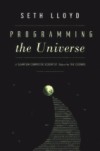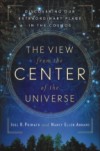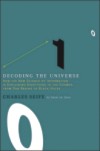|
Books
The Secrets of the Universe
 Programming the Universe: A Quantum Computer Scientist Tales on the Cosmos Programming the Universe: A Quantum Computer Scientist Tales on the Cosmos
Seth Lloyd
Knopf Publishing Group; March 2006
Lloyd, a professor at MIT, works in the vanguard of research in quantum computing: using the quantum mechanical properties of atoms as a computer. He contends that the universe itself is one big quantum computer producing what we see around us, and ourselves, as it runs a cosmic program. According to Lloyd, once we understand the laws of physics completely, we will be able to use small-scale quantum computing to understand the universe completely as well. In his scenario, the universe is processing information. The second law of thermodynamics (disorder increases) is all about information, and Lloyd spends much of the book explaining how quantum processes convey information. The creation of the universe itself involved information processing: random fluctuations in the quantum foam, like a random number generator in a computer program, produced higher-density areas, then matter, stars, galaxies and life. Lloyd's hypothesis bears important implications for the red-hot evolution-versus-intelligent design debate, since he argues that divine intervention isn't necessary to produce complexity and life. Unfortunately, he rushes through what should be the climax of his argument. Nevertheless, Lloyd throws out many fascinating ideas.
 The View from the Centre of the Universe The View from the Centre of the Universe
Joel R. Primack & Nancy Ellen Abrams
Penguin Group (USA); April 2006
A world-renowned astrophysicist and a science philosopher present a new, scientifically supported understanding of the universe, one that will forever change our personal relationship with the cosmos. For four hundred years, since early scientists discovered that the universe did not revolve around the earth, people have felt cut off-adrift in a meaningless cosmos. That is about to change. In their groundbreaking new book, The View from the Center of the Universe, Joel R. Primack, one of the world's leading cosmologists, and Nancy Ellen Abrams, a philosopher and writer, use recent advances in astronomy, physics, and cosmology to frame a compelling new theory of how to understand the universe and our role in it. While most of us think of the universe as empty space peppered with stars separated by vast distances, the truth, the authors argue, is far richer and more meaningful. For the first time in history, we know that the universe is more coherent and spiritually significant than anyone ever imagined and that our place in it is actually central to the expanding universe in important ways. According to Primack and Abrams, this new cosmology clarifies how the universe operates, what it's made of, how it may have originated, and how it is evolving. Even more surprising, these startling ideas spring from both cutting-edge science and the metaphors of ancient symbols. The result is a very human book that satisfies our fundamental need for order and meaning in our world and in our lives.
 Decoding the Universe Decoding the Universe
Charles Siefe
Penguin Group (USA); February 2006
As Charles Seife reveals in this energetic new book, information theory, once the province of philosophers and linguists, has emerged as the crucial science of our time, shedding new light on the mysteries of physics, the nature of space, time, the creation and the destruction of the universe itself. With his gift for making cutting-edge science accessible and entertaining, Seife explains how theorists came to understand that information is not a construct of the mind but a fundamental element of the physical world, something that sits inside every living cell and surrounds every black hole in the cosmos. It exists, like energy, even if there is no life to observe it. Starting with the breaking of the Enigma code during World War II and building momentum with the computer revolution, information theory has taken its place at the forefront of theoretical physics as scientists begin to use it to reconcile the paradoxes of relativity and quantum mechanics that have puzzled theorists since Einstein. Lucid and exhilarating, Decoding the Universe probes the mind-boggling advances that are taking us to the brink of a new understanding of the universe.
Compiled by SANYAT SATTAR
Copyright (R) thedailystar.net 2006 |
